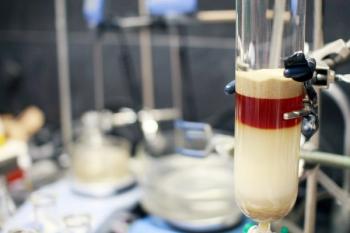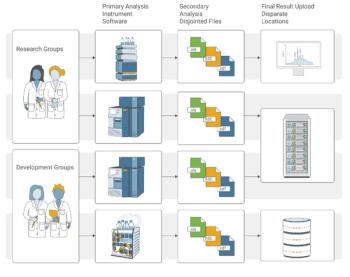
- LCGC Europe-05-01-2017
- Volume 30
- Issue 5
Supplementary Information: Combining HIC, SEC, and IEX with Fluorescence Polarization for Drug Target Discovery
This information is supplementary to the article “Combining HIC. SEC, and IEX with Fluorescence Polarization for Drug Target Discovery” that was published in the May 2017 issue of LCGC Europe.
Supplementary Figure 1: (A) Competition between active analogue OD270 and inactive analogue OD198 for 161-FLU binding in TNKS2a. (B) Fluorescence polarization competition binding between TNKS2a and 161-FLU with active analogue OD270 (A), active analogue OD139 (C), and inactive analogue OD198 (D). The assay was performed in a 96-well plate with 200 μL 10 nM 161-FLU added to each well, and 20 μL TNKS2a dissolved in buffer so that the protein:drug ratio was 75. 4 μL competitor in DMSO was added to each well in concentrations from -3 log(competitor:161-FLU) 3 in 10-fold dilutions.
Supplementary Figure 2: LC salt influence on FP signal in a 384-well plate with 30 μL 1 μg/mL XAV-FLU and 10 μL of each solvent added. The SEC solvents contained 0.05 mM NaH
2
PO
4
and various amounts of NaCl (max concentration 0.3 M) in the concentration ranges used for LC and pH adjusted to 7. The IEX solvents contained 0.02 M MES and various amounts of NaCl (max concentration 0.8 M), pH adjusted to 6. The HIC solvents contained 0.05 M NaH
2
PO
4
and various amounts of (NH
4
)
2
SO
4
(maximum concentration 2 M) pH adjusted to 7.
Supplementary Figure 3: nanoLC–ESI-MS chromatogram of trypsin-digested digested fractions from IEX, HIC, and SEC. A 4 μL sample was injected and separated on a temperature regulated (80 °C) silica-based C
18
monolithic column. Separation was done with linear gradient elution from 5% to 90% acetonitrile containing 0.1% formic acid (FA) (
v/v
) in 30 min (for samples A–C) and 5% to 45% acetonitrile containing 0.1% (
v/v
) FA in 25 min for sample D. A wash-out step for 5 min at 90% acetonitrile was applied in all of the separations. The flow rate was set to 2 μL/min. The MS used was a LTQ Orbitrap scanning from 300 to 1700
m/z
selecting top 10 peaks for MS/MS fragmentation. Venn diagram showing TNKS2a as common protein after LC–MS/MS analysis of TP fractions from SEC, HIC, and IEX that showed binding with XAV-FLU.
Supplementary Figure 4: IEX–UV chromatogram of a standard protein separation with different gradient lengths. Protein sample was separated at 1 mL/min using gradient elution on a 4.6 mm x 200 mm mixed-bed ion-exchange column. The column was temperature regulated at 20 °C. MP A contained 20 mM MES at pH 6 and 20 mM MES and 0.8 M NaCl at pH 6. 100 μL protein standard sample containing (1) carbonic anhydrase, (2) hemoglobin, (3) conalbumin, and (4) lysozyme was injected. The gradient started at 100% A for 5 min and then a linear increase to 52.5% A with lengths from 20 to 180 min, and a final wash-out step at 0% A for 10 min. Equilibration was done for 25 min prior to the next injection at 100% A.
Supplementary Figure 5: HIC–UV chromatogram of protein mixture containing (1) cytochrome C, (2) myoglobin, (3) ribonuclease B, and (4) chymotrypsinogen separated on a 4.6 x 200 mm Propac HIC-10 column, which was temperature regulated at 20 °C. The flow rate was 1 mL/min with 100 μL injected. Proteins were separated using gradient elution with 100% MP for 5 min then a linear decrease to 0% MP A in (A) 20, (B) 40, (C) 80, (D) 120, (E) 240 min with a final hold for 5 min at 0% MP A. Equilibration was performed for 30 min between runs at 100% MP A. MP A contained 2 M ammonium sulfate + 0.05 M sodium phosphate at pH 7 and MP B contained 0.05 M sodium phosphate at pH 7.
Supplementary Figure 6: SEC–UV chromatogram of protein standards separated at 0.35 mL/min using isocratic elution on a 4.6 mm x 30 cm size-exclusion column. Injection volume was 100 μL. The column was temperature regulated at 20 °C and mobile phase consisted of 0.05 M sodium phosphate and 0.3 M sodium chloride in water at pH 7. Autosampler temperature was 4 °C.
Articles in this issue
over 8 years ago
(U)HPLC: The Shape of Things To Comeover 8 years ago
The Role of LC–MS in Lipidomicsover 8 years ago
Contemporary Trends in Biopharmaceutical Analysisover 8 years ago
Advances in Glycomics in Biology and Medicineover 8 years ago
The Rising Profile of Comprehensive 2D LCover 8 years ago
New Gas Chromatography Products for 2016–2017Newsletter
Join the global community of analytical scientists who trust LCGC for insights on the latest techniques, trends, and expert solutions in chromatography.




